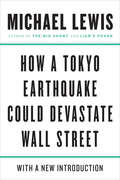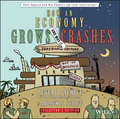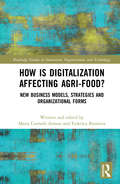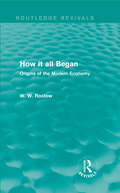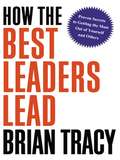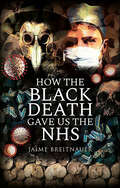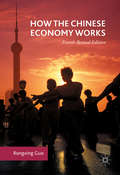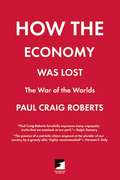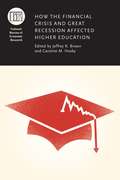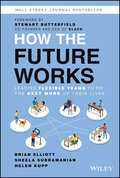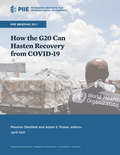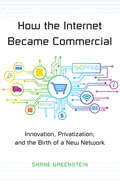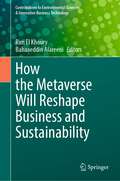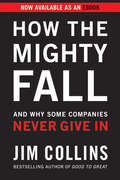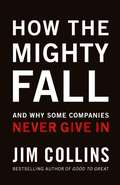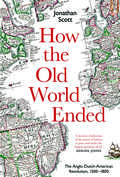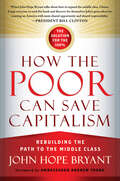- Table View
- List View
How a Second Grader Beats Wall Street
by Allan S. RothStraightforward strategies from a successful young investorIn How a Second Grader Beats Wall Street, you'll follow the story of Kevin Roth, an eight-year-old who was schooled in simple approaches to sound investing by his father, seasoned financial planner Allan Roth, and discover exactly how simple it can be to become a successful investor. Page by page, you'll learn how to create a portfolio with the widest diversification and lowest costs; one that can move up your financial freedom by a decade and dramatically increase your spending rate during retirement. And all this can be accomplished by using some common sense techniques.Along the way, Kevin and his dad discuss fresh, new approaches to investing, and detail some tried-and-true, but lesser known approaches. They also take the time to debunk the financial myths and legends that many of us accept as true, and show you what it really takes to build long-term wealth with less risk.Discusses how to design a portfolio composed of a few basic building blocks that can be "tweaked" to fit your personal needsAddresses how you can reengineer your portfolio in order to stop needlessly paying taxesReveals how you can increase returns, regardless of which direction the market goes, by picking the "low-hanging fruit" we all have in our portfoliosWith just a little time and a little work, you can become a better investor. With this book as your guide, you'll discover how a simpler approach to today's markets can put you on the path to financial independence.
How a Tokyo Earthquake Could Devastate Wall Street
by Michael LewisIn 1989, Michael Lewis reported on the potential effects of an earthquake in Japan on world financial markets. His insights are once again timely, and they are presented here as a stand-alone essay with a new introduction: "Real Versus Imaginary Japanese Earthquakes." In the late 1980s, Japanese scientists were trying to figure out the economic damage that would be caused if a catastrophic earthquake destroyed Tokyo. The answer was bleak, but not for Japan. Kaoru Oda, an economist who worked for Tokai Bank, speculated that the United States would end up paying the most. Why? Japan owned trillions of dollars' worth of foreign liquid assets and investments. These assets, which the world depended on, would be sold, forcing countries into the precarious position of having to return large amounts of money they might not have. After the recent earthquake, Michael Lewis reexamined this hypothesis and came to a surprising conclusion. With his characteristic sense of humor and wit, Lewis, once again, explains the inner workings of a financial catastrophe. "How a Tokyo Earthquake Could Devastate Wall Street" appears in Michael Lewis's book The Money Culture.
How an Economy Grows and Why It Crashes
by Andrew J. Schiff Peter D.How an Economy Grows and Why it Crashes uses illustration, humor, and accessible storytelling to explain complex topics of economic growth and monetary systems. In it, economic expert and bestselling author of Crash Proof, Peter Schiff teams up with his brother Andrew to apply their signature "take no prisoners" logic to expose the glaring fallacies that have become so ingrained in our country?s economic conversation. Inspired by How an Economy Grows and Why It Doesn?t?a previously published book by the Schiffs? father Irwin, a widely published economist and activist?How an Economy Grows and Why It Crashes?incorporates the spirit of the original while tackling the latest economic issues. With wit and humor, the Schiffs explain the roots of economic growth, the uses of capital, the destructive nature of consumer credit, the source of inflation, the importance of trade, savings, and risk, and many other topical principles of economics. The tales told here may appear simple of the surface, but they will leave you with a powerful understanding of How an Economy Grows and Why it Crashes.
How an Economy Grows and Why It Crashes
by Peter D. Schiff Andrew J. SchiffStraight answers to every question you've ever had about how the economy works and how it affects your lifeIn this Collector's Edition of their celebrated How an Economy Grows and Why It Crashes, Peter Schiff, economic expert and bestselling author of Crash Proof and The Real Crash, once again teams up with his brother Andrew to spin a lively economic fable that untangles many of the fallacies preventing people from really understanding what drives an economy. The 2010 original has been described as a "Flintstones" take economics that entertainingly explains the beauty of free markets. The new edition has been greatly expanded in both quantity and quality. A new introduction and two new illustrated chapters bring the story up to date, and most importantly, the book makes the jump from black and white to full and vivid color.With the help of colorful cartoon illustrations, lively humor, and deceptively simple storytelling, the Schiff's bring the complex subjects of inflation, monetary policy, recession, and other important topics in economics down to Earth. The story starts with three guys on an island who barely survive by fishing barehanded. Then one enterprising islander invents a net, catches more fish, and changes the island's economy fundamentally. Using this story the Schiffs apply their signature take-no-prisoners logic to expose the glaring fallacies and gaping holes permeating the global economic conversation. The Collector's Edition:Provides straight answers about how economies work, without relying on nonsensical jargon and mind-numbing doublespeak the experts use to cover up their confusionIncludes a new introduction that sets the stage for developing a deeper, more practical understanding of inflation and the abuses of the monetary systemAdds two new chapters that dissect the Federal Reserve's Quantitative easing policies and the European Debt Crisis. Colorizes the original book's hundreds of cartoon illustrations. The improved images, executed by artist Brendan Leach from the original book, add new vigor to the presentationHas a larger format that has been designed to fit most coffee tables. While the story may appear simple on the surface, as told by the Schiff brothers, it will leave you with a deep understanding of How an Economy Grows and Why It Crashes.
How do You Make Money Renting Toys?: Technical guide for beginners – Book I
by Pílula DigitalAll the strategies and information that you will read in this book, and that I learned when I entered the business of renting toys for parties and events, are the result of my professional experiences in this area. Although I have made every effort to ensure the accuracy and highest quality of this information to make the techniques and methods taught here highly effective for anyone willing to learn and apply them, these methods and information have not been tested or proven scientifically, but in practice. The strategies and information presented here are for everyone, but they are not for everybody. You need to be eager to learn them.
How is Digitalization Affecting Agri-food?: New Business Models, Strategies and Organizational Forms (Routledge Studies in Innovation, Organizations and Technology)
by Maria Carmela AnnosiUsing real cases of food fi rms and agriculture supply chains as a context, How is Digitalization Affecting Agri-food? New Business Models, Strategies and Organizational Forms aims to understand the key themes in strategic and organizational research in this area. Despite the importance of food and agriculture in the current political and societal context, analysis of the impact of digitalization and information technologies on the industry is still limited. The objective of this monograph is to understand the direction of this change. With case studies of food firms and agriculture supply chains it sets out to conceptualize food organizing and organizations as a fruitful object of inquiry, both at the intra and interorganizational levels. It aims to understand new business models, strategies, and organizational forms. Contributions in this stream of research have the potential to yield important and relevant insights for both scholars and societies. This book is written primarily for academics engaged in innovation management or strategy, or conducting organizational behavior research. It will also be of relevance to practitioners and managers in the agri-food industry.
How it all Began: Origins of the Modern Economy (Routledge Revivals)
by W. W. RostowFirst published in 1975, this book traces the origins of our modern economy, showing the routes by which nations have either achieved wealth or have been impoverished. W. W. Rostow brings together issues of public policy, international trade and the world of science and technology, arguing that conventional economic thought has failed to relate scientific innovation to the economic process. Chapters consider the politics of modernization, the Commercial Revolution and the development of the world economy between 1783 and 1820.
How the Best Leaders Lead: Proven Secrets to Getting the Most Out of Yourself and Others
by Brian TracyThe world&’s greatest business leaders make it all look easy because they keep it simple: measurable, repeatable methods that generate exceptional results in both strong markets and weak, good economies and bad.Leadership expert Brian Tracy has guided countless thousands of professionals, executives, and leaders of all stripes to truly startling results through his business books, seminars and consulting work.In How the Best Leaders Lead, Tracy breaks down the art and science of business leadership into the seven fundamental responsibilities that outstanding leaders master. Essential for success in any organization and every leadership position, they are:Setting and achieving goalsFostering innovationProblem solving and decision makingSetting prioritiesSetting high standards and leading by exampleInspiring and motivating othersPerforming and achieving resultsThis book will take you through a thorough self-analysis with which you will discover what is truly important to you—and identify the specific steps you must take to achieve it. You&’ll then listen Tracy&’s life-changing lessons culled from the leading edges of business, the annals of history and military strategy, and the wisdom of the world&’s most powerful leadership and management thinkers past and present.Leadership is an exact science but a simple one, born of clear vision and courage, self -knowledge and integrity, focus and confidence. With acute insight and Tracy&’s accessible guidance, How the Best Leaders Lead brings those powerful attributes and leadership greatness easily within your reach.
How the Black Death Gave Us the NHS
by Jaime BreitnauerAs the world is gripped by the coronavirus pandemic, all eyes in the UK have been on our NHS heroes. But where did they come from? Why do we have such a unique free at the point of use healthcare system? How has this benefitted British society? And how does healthcare in other countries work? Going back to pre-history, we will take a look at epidemics and pandemics through the ages and how they have consistently nudged healthcare policy toward a more social model. They say a measure of civilised society is how it provides for its citizens, and the NHS has been the backbone of Great Britain for the best part of a century. As well as looking at its origins and counterparts in other countries, we will take a look at how the Covid-19 pandemic has been handled, and what the future of social healthcare might be across the globe.
How the Chinese Economy Works
by Rongxing GuoThis fourth revised edition sets out to analyze and compare the operational mechanisms of the Chinese economy between the pre- and post-reform periods and through national, regional and local dimensions. It examines the driving forces - both endogenous and exogenous - that have influenced China's economic development during the past decades. Both positive and negative consequences of the Chinese economic transformation have been clarified. A multiregional comparison of the Chinese economy is conducted in terms of natural and human resources, institutional evolution, as well as economic and social performances. This enlarged edition includes three new chapters on cultural diversity; natural and environmental resources; and, political and administrative systems. Many of the original chapters have also been significantly revised, expanded and updated according to more recent research.
How the Economy Was Lost: The War of the Worlds
by Paul Craig RobertsAn outline of how the economy works by an insider-turned-outsider. Roberts breaks down how our recent recession came about, how deep it will get, and how we can avoid one in the future.
How the Financial Crisis Affects Pensions and Insurance and Why the Impacts Matter
by Gregorio Impavido Ian TowerA report from the International Monetary Fund.
How the Financial Crisis and Great Recession Affected Higher Education (National Bureau of Economic Research Conference Report)
by Jeffrey R. Brown and Caroline M. HoxbyThe recent financial crisis had a profound effect on both public and private universities, which faced shrinking endowments, declining charitable contributions, and reductions in government support. Universities responded to these stresses in different ways. This volume presents new evidence on the nature of these responses, and on how the incentives and constraints facing different institutions affected their behavior. The studies in this volume explore how various practices at institutions of higher education, such as the drawdown of endowment resources, the awarding of financial aid, and spending on research, responded to the financial crisis. The studies examine universities as economic organizations that operate in a complex institutional and financial environment. The authors examine the role of endowments in university finances and the interaction of spending policies, asset allocation strategies, and investment opportunities. They demonstrate that universities’ behavior can be modeled using economic principles.
How the Future Works: Leading Flexible Teams To Do The Best Work of Their Lives
by Brian Elliott Sheela Subramanian Helen KuppUnlock the power of flexible work with this practical “how-to” guide from the leadership of Slack and Future Forum The way we work has changed. The era of toiling from nine-to-five, five-days-a-week in the office is now a relic of the past, and is being replaced by a better way—flexible work. But flexibility means a lot more than a day or two a week to “work from home”: 93% of your employees want more flexibility in when, not just where, they work. They want choice and they are leaving their roles to find it. The most successful leaders will go much further than offering occasional remote workdays—they will redesign every aspect of how work gets done, from defining how they measure organizational success to training their managers to make it happen. How the Future Works: Leading Flexible Teams to Do The Best Work of Their Lives offers a blueprint for using flexible work to unlock the potential of your people. The book offers the steps necessary to building the new principles and guardrails to empower flexible, high-performing teams. And it teaches readers to lead with purpose, to manage and measure differently, and to believe that by letting go, they’ll get more back than they thought possible. How the Future Works explains how to: Establish leadership principles, commitments, and outcomes for truly flexible teamwork Measure and assess productivity in a flexible workplace Reskill managers to ensure a level playing field for all employees Implement the infrastructure necessary to make flexible work successful Using original research from Future Forum, a consortium by Slack, and global case studies from leading companies such as Levi Strauss & Co., Genentech, Royal Bank of Canada, and IBM, How the Future Works offers concrete solutions and practical steps for building high functioning teams of talented, engaged people by providing them with the flexibility and choice they need to do their best work.
How the G20 Can Hasten Recovery from COVID-19
by Maurice Obstfeld Adam S. PosenThe world's leading economic powers must cooperate more to combat the health and economic shocks resulting from the COVID-19 pandemic. In a new free eBook, PIIE Briefing, How the G20 can hasten recovery from COVID-19, Peterson Institute experts outline how collective action by the Group of Twenty (G20) nations can make a difference. The PIIE agenda includes removal of trade barriers impeding the flow of medical supplies and food, and more money for research, testing, and disease control, especially for debt-burdened low-income countries. The World Bank and the World Health Organization need more resources to relieve suffering, and the International Monetary Fund must step up to stabilize the world financial system.
How the Internet Became Commercial
by Shane GreensteinIn less than a decade, the Internet went from being a series of loosely connected networks used by universities and the military to the powerful commercial engine it is today. This book describes how many of the key innovations that made this possible came from entrepreneurs and iconoclasts who were outside the mainstream--and how the commercialization of the Internet was by no means a foregone conclusion at its outset.Shane Greenstein traces the evolution of the Internet from government ownership to privatization to the commercial Internet we know today. This is a story of innovation from the edges. Greenstein shows how mainstream service providers that had traditionally been leaders in the old-market economy became threatened by innovations from industry outsiders who saw economic opportunities where others didn't--and how these mainstream firms had no choice but to innovate themselves. New models were tried: some succeeded, some failed. Commercial markets turned innovations into valuable products and services as the Internet evolved in those markets. New business processes had to be created from scratch as a network originally intended for research and military defense had to deal with network interconnectivity, the needs of commercial users, and a host of challenges with implementing innovative new services.How the Internet Became Commercial demonstrates how, without any central authority, a unique and vibrant interplay between government and private industry transformed the Internet.
How the Metaverse Will Reshape Business and Sustainability (Contributions to Environmental Sciences & Innovative Business Technology)
by Bahaaeddin Alareeni Rim El KhourySustainability is part of every aspect of our life, with climate concerns shaping the future. Thus, it is important to understand how metaverse will affect sustainability, as it is opening both challenges and opportunities for environmental sustainability. On the one side, replacing real-world interactions with 3D virtual and exchanging physical goods with digital ones are significantly less resource-intensive and more carbon-efficient. Therefore, this holds the promise of reducing the environmental pollution. On the other side, metaverse increases e-waste and energy consumption. Given this controversial impact, it is crucial for businesses and researchers to understand how to ensure that the metaverse develops sustainably. This book is popping out several questions: Do businesses understand the metaverse concept and perceive the benefits and advantages of implementing such technologies? How will the metaverse change business? Will metaverse change our working place and skills needed? How can companies get ahead of the change and mold it to their advantage? Will businesses use metaverse? Can metaverse create a more sustainable word? How can we make the metaverse better than what we have now? Is it going to affect environmental sustainability? Will it cause more severe climate problems, or would it be the solution? How can metaverse impact the achievements of SDGs?
How the Mighty Fall
by Jim CollinsDecline can be avoided. Decline can be detected. Decline can be reversed. Amidst the desolate landscape of fallen great companies, Jim Collins began to wonder: How do the mighty fall? Can decline be detected early and avoided? How far can a company fall before the path toward doom becomes inevitable and unshakable? How can companies reverse course? In How the Mighty Fall, Collins confronts these questions, offering leaders the well-founded hope that they can learn how to stave off decline and, if they find themselves falling, reverse their course. Collins' research project-more than four years in duration-uncovered five step-wise stages of decline: Stage 1: Hubris Born of Success Stage 2: Undisciplined Pursuit of More Stage 3: Denial of Risk and Peril Stage 4: Grasping for Salvation Stage 5: Capitulation to Irrelevance or Death By understanding these stages of decline, leaders can substantially reduce their chances of falling all the way to the bottom. Great companies can stumble, badly, and recover. Every institution, no matter how great, is vulnerable to decline. There is no law of nature that the most powerful will inevitably remain at the top. Anyone can fall and most eventually do. But, as Collins' research emphasizes, some companies do indeed recover-in some cases, coming back even stronger-even after having crashed into the depths of Stage 4. Decline, it turns out, is largely self-inflicted, and the path to recovery lies largely within our own hands. We are not imprisoned by our circumstances, our history, or even our staggering defeats along the way. As long as we never get entirely knocked out of the game, hope always remains. The mighty can fall, but they can often rise again.
How the Mighty Fall
by Jim CollinsDecline can be avoided. Decline can be detected. Decline can be reversed. Amidst the desolate landscape of fallen great companies, Jim Collins began to wonder: How do the mighty fall? Can decline be detected early and avoided? How far can a company fall before the path toward doom becomes inevitable and unshakable? How can companies reverse course? In How the Mighty Fall, Collins confronts these questions, offering leaders the well-founded hope that they can learn how to stave off decline and, if they find themselves falling, reverse their course. Collins' research project--more than four years in duration--uncovered five step-wise stages of decline: Stage 1: Hubris Born of Success Stage 2: Undisciplined Pursuit of More Stage 3: Denial of Risk and Peril Stage 4: Grasping for Salvation Stage 5: Capitulation to Irrelevance or Death By understanding these stages of decline, leaders can substantially reduce their chances of falling all the way to the bottom. Great companies can stumble, badly, and recover. Every institution, no matter how great, is vulnerable to decline. There is no law of nature that the most powerful will inevitably remain at the top. Anyone can fall and most eventually do. But, as Collins' research emphasizes, some companies do indeed recover--in some cases, coming back even stronger--even after having crashed into the depths of Stage 4. Decline, it turns out, is largely self-inflicted, and the path to recovery lies largely within our own hands. We are not imprisoned by our circumstances, our history, or even our staggering defeats along the way. As long as we never get entirely knocked out of the game, hope always remains. The mighty can fall, but they can often rise again.
How the Mighty Fall: And Why Some Companies Never Give In
by Jim CollinsDecline can be avoided. Decline can be detected. Decline can be reversed. Amidst the desolate landscape of fallen great companies, Jim Collins began to wonder: How do the mighty fall? Can decline be detected early and avoided? How far can a company fall before the path toward doom becomes inevitable and unshakable? How can companies reverse course? In How the Mighty Fall, Collins confronts these questions, offering leaders the well-founded hope that they can learn how to stave off decline and, if they find themselves falling, reverse their course. Collins' research project-more than four years in duration-uncovered five step-wise stages of decline: Stage 1: Hubris Born of Success, Stage 2: Undisciplined Pursuit of More, Stage 3: Denial of Risk and Peril, Stage 4: Grasping for Salvation, Stage 5: Capitulation to Irrelevance or Death. By understanding these stages of decline, leaders can substantially reduce their chances of falling all the way to the bottom. Great companies can stumble, badly, and recover. Every institution, no matter how great, is vulnerable to decline. There is no law of nature that the most powerful will inevitably remain at the top. Anyone can fall and most eventually do. But, as Collins' research emphasizes, some companies do indeed recover--in some cases, coming back even stronger-even after having crashed into the depths of Stage 4. Decline, it turns out, is largely self-inflicted, and the path to recovery lies largely within our own hands. We are not imprisoned by our circumstances, our history, or even our staggering defeats along the way. As long as we never get entirely knocked out of the game, hope always remains. The mighty can fall, but they can often rise again.
How the Net Promoter Score (NPS) Can Drive Growth: The Economic Advantage of Superior Customer Relationships
by Fred ReichheldCompanies need to understand the economic value that results from building better customer relationships. This chapter looks at some real-life examples of high-quality customer relationships generating economic benefits. This chapter was originally published as Chapter 3 of "The Ultimate Question: Driving Good Profits and True Growth."
How the Old World Ended: The Anglo-Dutch-American Revolution 1500-1800
by Jonathan ScottA magisterial account of how the cultural and maritime relationships between the British, Dutch and American territories changed the existing world order – and made the Industrial Revolution possible Between 1500 and 1800, the North Sea region overtook the Mediterranean as the most dynamic part of the world. At its core the Anglo-Dutch relationship intertwined close alliance and fierce antagonism to intense creative effect. But a precondition for the Industrial Revolution was also the establishment in British North America of a unique type of colony – for the settlement of people and culture, rather than the extraction of things. England&’s republican revolution of 1649–53 was a spectacular attempt to change social, political and moral life in the direction pioneered by the Dutch. In this wide-angled and arresting book Jonathan Scott argues that it was also a turning point in world history. In the revolution&’s wake, competition with the Dutch transformed the military-fiscal and naval resources of the state. One result was a navally protected Anglo-American trading monopoly. Within this context, more than a century later, the Industrial Revolution would be triggered by the alchemical power of American shopping
How the Other Half Banks: Exclusion, Exploitation, and the Threat to Democracy
by Mehrsa BaradaranThe United States has two separate banking systems--one serving the well-to-do and another exploiting everyone else. Deserted by banks and lacking credit, many people are forced to wander through a Wild West of payday lenders and check-cashing services thanks to the effects of deregulation in the 1970s that continue today, Mehrsa Baradaran shows.
How the Other Half Works: Immigration and the Social Organization of Labor
by Michael I. Lichter Roger WaldingerA beautifully written, clear portrait of how low-skilled workers in Los Angeles get jobs in six industries (department stores, restaurants, printing, hospitals, hotels, and furniture manufacturing). Grounded in the best research and interviews with more than 200 employers, this book show us the human dynamics behind the statistics.
How the Poor Can Save Capitalism: Rebuilding the Path to the Middle Class
by John Hope BryantJohn Hope Bryant, successful self-made businessman and founder of the nonprofit Operation HOPE, says business and political leaders are ignoring the one force that could truly re-energize the stalled American economy: the poor. If we give poor communities the right tools, policies, and inspiration, he argues, they will be able to lift themselves up into the middle class and become a new generation of customers and entrepreneurs. Raised in poverty-stricken, gang-infested South Central Los Angeles, Bryant saw firsthand how our institutions have abandoned the poor. He details how business loans, home loans, and financial investments have vanished from their communities. After decades of deprivation, the poor lack bank accounts, decent credit scores, and any real firsthand experience of how a healthy free enterprise system functions. Bryant radically redefines the meaning of poverty and wealth. (It's not just a question of finances; it's values too.) He exposes why attempts to aid the poor so far have fallen short and offers a way forward: the HOPE Plan, a series of straightforward, actionable steps to build financial literacy and expand opportunity so that the poor can join the middle class. Fully 70 percent of the American economy is driven by consumer spending, but more and more people have too much month at the end of their money. John Hope Bryant aspires to "expand the philosophy of free enterprise to include all of God's children" and create a thriving economy that works not just for the 1 percent or even the 99 percent but for the 100 percent. This is a free enterprise approach to solving the problem of poverty and raising up a new America.

